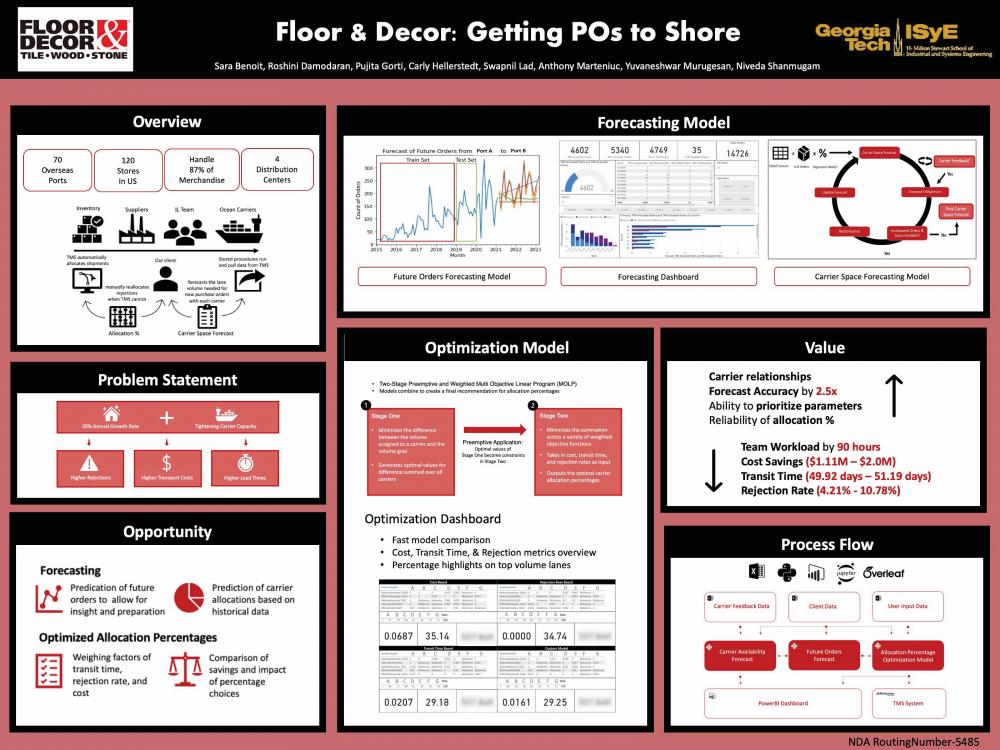Client Context
Our client is the International Logistics team at Floor & Decor. Floor & Decor the largest hard surface flooring retailer in the US - 87% of their merchandise is from international vendors, and they use lanes (a lane being an international origin port to a destination port in the US) to deliver these orders via ocean carriers. The team uses a TMS (transportation management system) software to allocate space to different ocean carriers for merchandise orders and they determine the percentages of orders they would like each carrier to take on a given lane. The team also attempts to have visibility into how orders are going to be allocated to different carriers by creating an 8-week forecast of predicted allocation of orders. They send this forecast to their ocean carriers to try and prepare the carriers for volume of orders Floor & Decor will request in order to avoid rejections from carriers.
Project Objective
Both the process of determining the percentages to feed into the allocation software and building the 8-week forecast are manual, time intensive processes that do not currently account for historic data (carrier costs, actual transit times, rejection rates, and the volume of orders a carrier has historically been able to take). With recent growth in the home improvement market and increasing rejections from carriers, Floor & Decor needs these processes to be more systematic and data driven. Our objective is therefore to reduce the amount of rejections they receive, lower transit time, and alleviate workload for the team.
Design Strategy
As far as design, the Future Orders forecasting model utilizes 5 different time-series forecasting methods consisting of both seasonal and non-seasonal methods. The model selects the method with the least amount of error for each lane. As mentioned, the output of the Future Orders forecasting model is fed into the Carrier Space forecasting model, which relies on a regression model combined with a series of tiered maximums to restrict the model to more accurate/realistic predictions. We validated this model using previous forecasts from our client compared to reality and found that the model was 2.5x more accurate. For optimization, we designed the model to be a two-stage linear model. The model’s first stage narrows down the possible solutions by finding the region in which carriers are close to their historic practices using preemptive optimization. The second stage takes the previously mentioned user inputs and uses a weighted linear function to minimize based on the parameter weightage. Our client needed a product that was flexible and able to be manipulated and customized easily, so we created a model in which different inputs and parameters could take different weights based on their importance as determined by the user.
Deliverables
Our deliverables that address these issues include two forecasting models, an optimization model, Power BI dashboard, and user guide. The Future Orders forecasting model we created predicts the number of orders that’s expected to ship in each month on a lane. The output from this model is fed into the Carrier Space forecasting model and the Allocation Percentages optimization models. The Carrier Space forecasting model predicts the number of orders that each ocean carrier is expected to handle out of the total orders on each shipping lane on a weekly basis. The Allocation Optimization model takes in parameters and user input to determine the best allocation of shipments across carriers on a lane. This model can be customized, as it allows the user to put different weights on various parameters (cost, transit time, rejection rate). The final output of the 2-stage multi-objective linear program feeds directly into TMS, the client’s internal allocation software, and Power BI, where the client is able to see the results for their custom model in terms of total cost, expected rejection rate, average transit time and an overview of the percentage breakdown. The user guide consists of a process flow highlighting how all the models are integrated, the inputs and outputs of the system, any diagnostic errors with troubleshooting guides, tutorials and FAQs.


